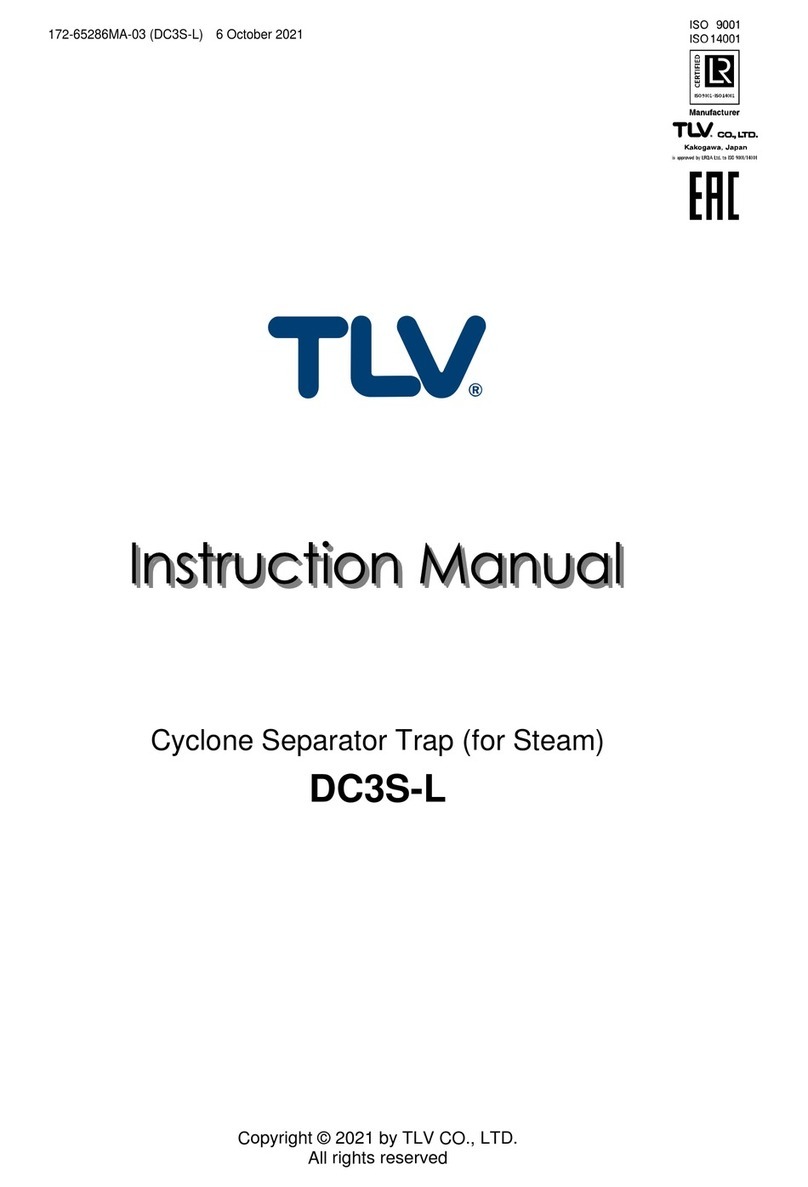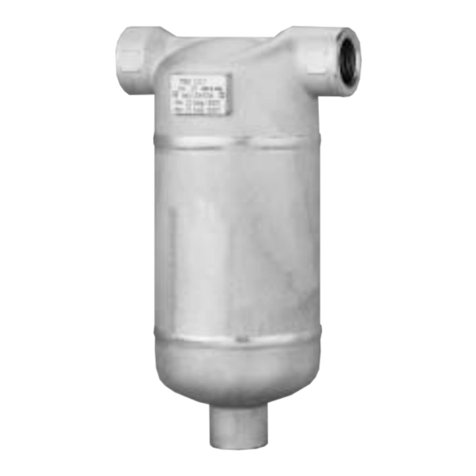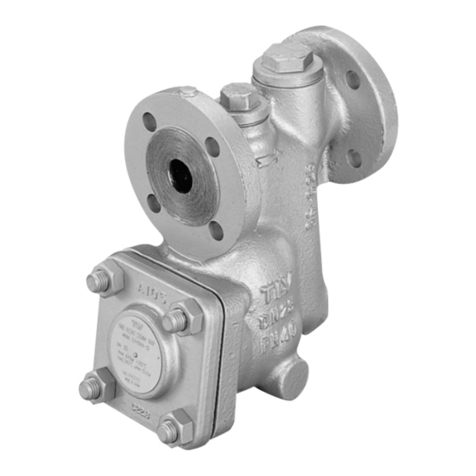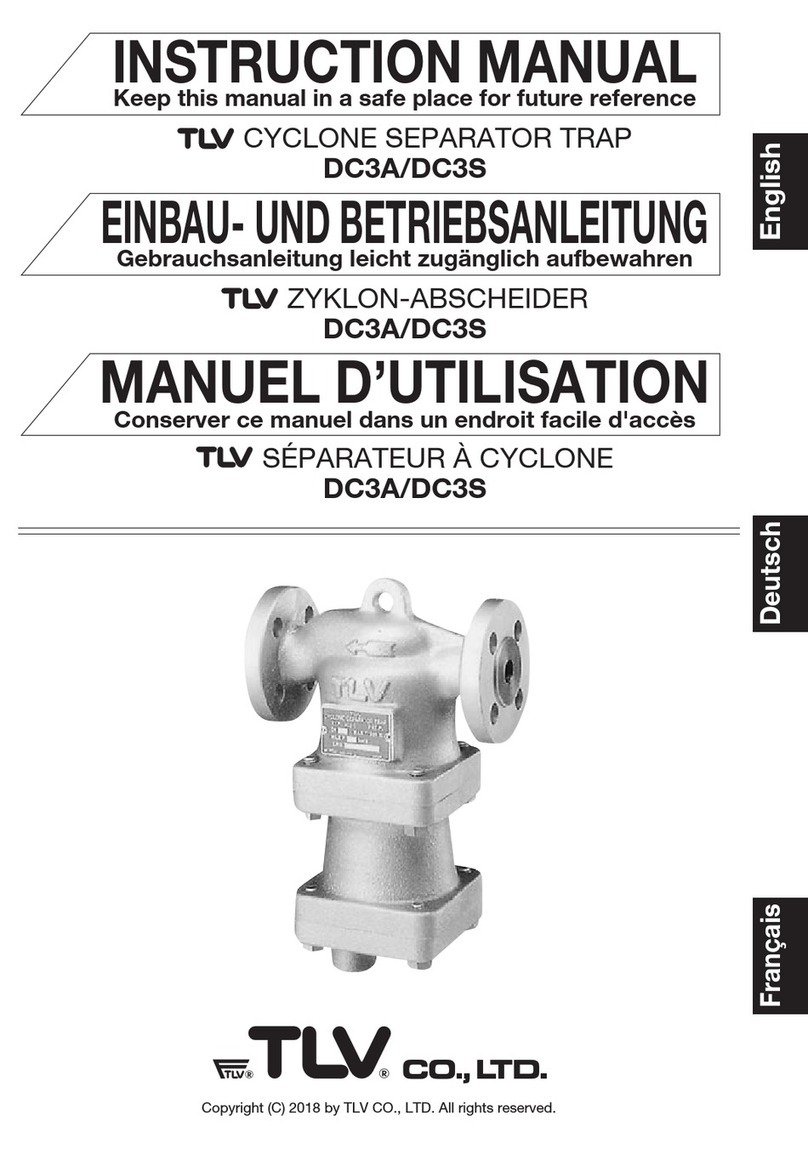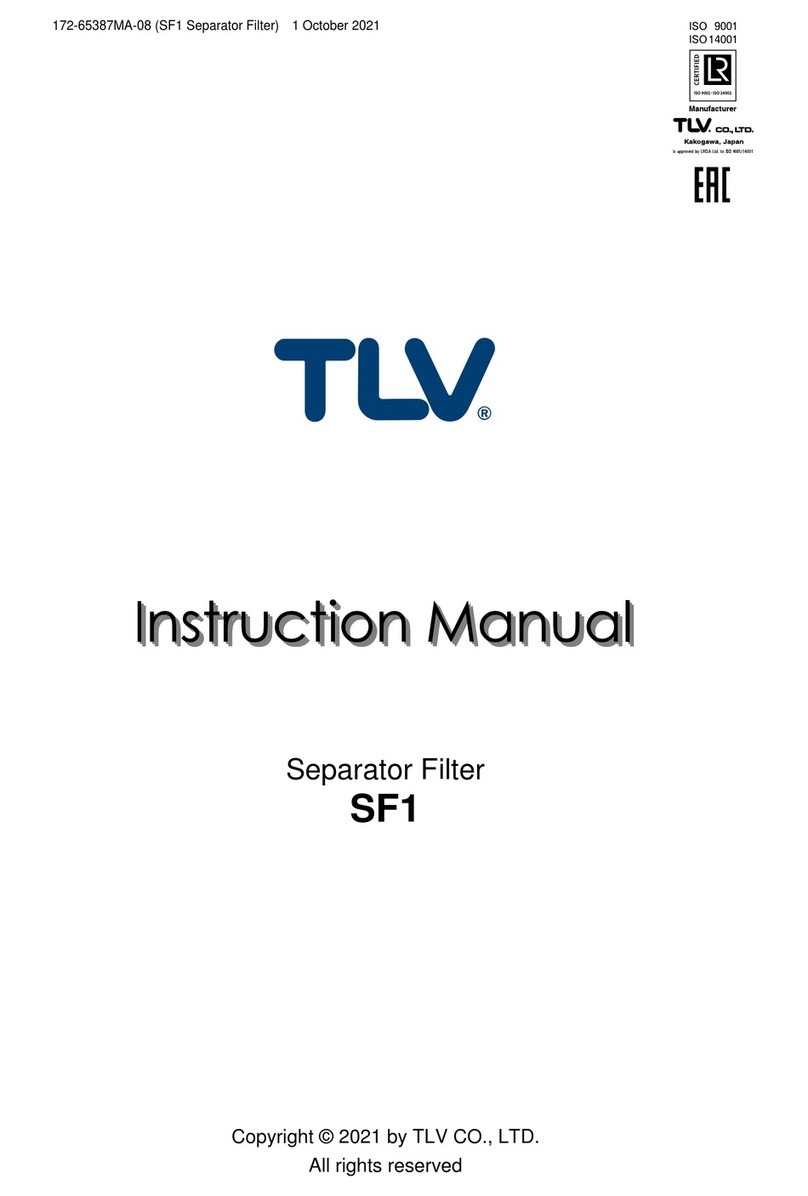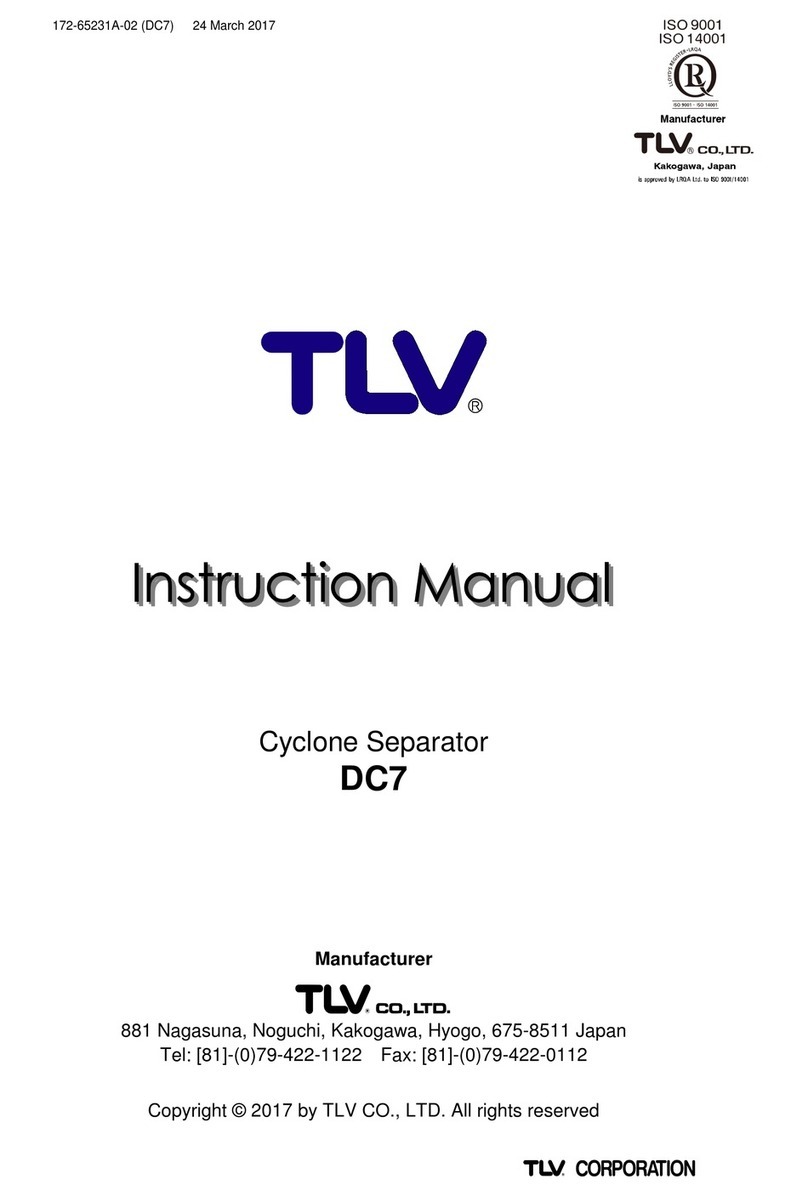TLV GAS1N User manual

172-65129A-03 (GAS1N/GAS2N/GAS3N) 23 October 2018
Manufacturer
881 Nagasuna, Noguchi, Kakogawa, Hyogo, 675-8511, Japan
Tel: [81]-(0)79-422-1122 Fax: [81]-(0)79-422-0112
Copyright © 2018 by TLV CO., LTD. All rights reserved
Free Float Gas Trap
GAS1N /GAS2N /GAS3N

172-65129A-03 (GAS1N/GAS2N/GAS3N) 23 Oct 2018
2
Contents
Introduction ........................................................................ 2
Safety Considerations........................................................ 3
Checking the Piping........................................................... 5
Operation ........................................................................... 6
Specifications..................................................................... 7
Configuration...................................................................... 8
Installation.......................................................................... 9
The Need for a Pressure-balancing Line ......................... 10
Secondary Side Precautions............................................ 10
Maintenance..................................................................... 11
Disassembly/Reassembly................................................ 12
Troubleshooting ............................................................... 14
EXPRESS LIMITED WARRANTY.......................... 15
Introduction
Thank you for purchasing the free float gas trap.
This product has been thoroughly inspected before being shipped from the factory.
When the product is delivered, before doing anything else, check the specifications
and external appearance to make sure nothing is out of the ordinary. Also be sure to
read this manual carefully before use and follow the instructions to be sure of using
the product properly.
If this product is used with toxic, flammable or otherwise hazardous fluids, all
responsibility for regulatorycompliance, product selection (including materials), handling,
safety measures, etc. for the hazardous fluid(s) must be borne bythe customer.
Under no circumstances will TLV CO., LTD. be liable for consequential economic
loss damage or consequential damage to property or persons caused by explosions,
poisoning or other accidents due to use with hazardous fluids.
This free float gas trap uses a precision-polished float and three-point seating for the
valve body. With no hinges or levers, the trap continuously discharges condensate,
preventing it from collecting. The three-point seating supports the precision-polished
float securely at three points and ensures a high degree of sealing when even only
minute quantities of condensate are present. The trap can also be disassembled and
reassembled while still installed in the piping, which results in considerable time
savings and facilitates repair and maintenance.
This gas trap’s outstanding features of the precision-polished float and three-point
seating, combined with a mechanism that has a proven record of success, increase
the efficiency of a variety of systems and reduce time and labor needed for
maintenance and bypass blowdown operations.
If detailed instructions for special order specifications or options not contained in this
manual are required, please contact for full details.
This instruction manual is intended for use with the model(s) listed on the front cover. It
is necessary not only for installation, but for subsequent maintenance, disassembly/
reassembly and troubleshooting. Please keep it in a safe place for future reference.

172-65129A-03 (GAS1N/GAS2N/GAS3N) 23 Oct 2018
3
Safety Considerations
Read this section carefully before use and be sure to follow the instructions.
Installation, inspection, maintenance, repairs, disassembly, adjustment and valve
opening/closing should be carried out only by trained maintenance personnel.
The precautions listed in this manual are designed to ensure safety and prevent
equipment damage and personal injury. For situations that may occur as a result
of erroneous handling, three different types of cautionary items are used to
indicate the degree of urgency and the scale of potential damage and danger:
DANGER, WARNING and CAUTION.
The three types of cautionary items above are very important for safety: be sure to
observe all of them as they relate to installation, use, maintenance, and repair.
Furthermore, TLV accepts no responsibility for any accidents or damage occurring
as a result of failure to observe these precautions.
Symbols
Indicates a DANGER, WARNING or CAUTION item.
DANGER
Indicates an urgent situation which poses a threat of death or
serious injury
WARNING
Indicates that there is a potential threat of death or serious injury
CAUTION
Indicates that there is a possibility of injury or equipment / product
damage
DANGER
When used with toxic, flammable or otherwise hazardous
fluids, manage properly and take appropriate safety measures
for the hazardous fluids in use.
Failure to do so may result in serious injury and/or severe damage
to property caused by blockage or fluid leakage.
WARNING
NEVER apply direct heat to the float.
The float may explode due to increased internal pressure, causing
accidents leading to serious injury or damage to property and
equipment.
CAUTION
Install properly and DO NOT use this product outside the
recommended operating pressure, temperature and other
specification ranges. This product is for intended use only.
Improper use may result in such hazards as damage to the product
or malfunctions that may lead to serious accidents. Local
regulations may restrict the use of this product to below the
conditions quoted.
DO NOT use this product in excess of the maximum operating
pressure differential.
Such use could make discharge impossible (blocked).
Safety considerations continued on next page.

172-65129A-03 (GAS1N/GAS2N/GAS3N) 23 Oct 2018
4
CAUTION
Use hoisting equipment for heavy objects (weighing
approximately 20 kg (44 lb) or more).
Failure to do so may result in back strain or other injury if the object
should fall.
Take measures to prevent people from coming into direct
contact with product outlets.
Failure to do so may result in burns or other injury from the
discharge of fluids.
When disassembling or removing the product, wait until the
internal pressure equals atmospheric pressure and the surface
of the product has cooled to room temperature.
Disassembling or removing the product when it is hot or under
pressure may lead to discharge of fluids, causing burns, other
injuries or damage.
Take measures to ensure the proper handling, such as
recovery or dilution, of hazardous fluids discharged at product
outlets.
Outflow of fluid or fluid leaks may lead to hazards such as
flammable conditions or corrosion, which may result in injury, fires,
damage or other accidents.
Be sure to use only the recommended components when
repairing the product, and NEVER attempt to modify the
product in any way.
Failure to observe these precautions may result in damage to the
product and burns or other injury due to malfunction or the
discharge of fluids.
Use only under conditions in which no freeze-up will occur.
Freezing may damage the product, leading to fluid discharge, which
may cause burns or other injury.

172-65129A-03 (GAS1N/GAS2N/GAS3N) 23 Oct 2018
5
Checking the Piping
Use only under conditions in which no water hammer will occur. The
impact of water hammer may damage the product, leading to fluid
discharge, which may cause burns or other injury.
CAUTION
Check to make sure that the pipes to be connected to the trap have been installed
properly.
1. Is the pipe diameter suitable?
2. Is the piping where the trap is to be installed horizontal?
3. Has sufficient space been secured for maintenance?
4. Have isolation valves and a strainer (40 mesh or finer) been installed at the inlet
and outlet? If the outlet is subject to back pressure, has a check valve been
installed?
5. Is the inlet pipe as short as possible, with as few bends as possible, and installed
so the liquid will flow naturally down into the trap?
6. Has the piping work been done correctly, as shown in the figures below?
Requirement
Correct
Incorrect
Install catchpot with the
proper diameter.
Diameter is too small.
Make sure the flow of
condensate is not
obstructed.
Diameter is too small and inlet
protrudes into pipe interior.
To prevent rust and scale
from flowing into the trap,
the inlet pipe should be
connected 25 –50 mm (1 –
2 in) above the base of the
T-pipe.
Rust and scale flow into the trap
with the condensate.
When installing on the blind
end, make sure the flow of
condensate is not
obstructed.
Condensate collects in the pipe.
This manual suits for next models
2
Table of contents
Other TLV Water Filtration System manuals
Popular Water Filtration System manuals by other brands

Atlantic Ultraviolet
Atlantic Ultraviolet Mighty Pure MP16A owner's manual

SunSun
SunSun CBG-500 Operation manual

Hayward
Hayward XStream Filtration Series owner's manual

Contech
Contech DownSpout StormFilter Operation and maintenance

Teka
Teka Airfilter MINI operating instructions

Wisy
Wisy LineAir 100 Installation and operating instructions

Schaffner
Schaffner Ecosine FN3446 Series User and installation manual

Pentair
Pentair FLECK 4600 SXT Installer manual

H2O International
H2O International H20-500 product manual

Renkforce
Renkforce 2306241 operating instructions

Neo-Pure
Neo-Pure TL3-A502 manual

STA-RITE
STA-RITE VERTICAL GRID DE FILTERS S7D75 owner's manual

